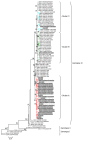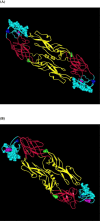Evolution of dengue virus type 3 genotype III in Venezuela: diversification, rates and population dynamics
- PMID: 21087501
- PMCID: PMC2998486
- DOI: 10.1186/1743-422X-7-329
Evolution of dengue virus type 3 genotype III in Venezuela: diversification, rates and population dynamics
Abstract
Background: Dengue virus (DENV) is a member of the genus Flavivirus of the family Flaviviridae. DENV are comprised of four distinct serotypes (DENV-1 through DENV-4) and each serotype can be divided in different genotypes. Currently, there is a dramatic emergence of DENV-3 genotype III in Latin America. Nevertheless, we still have an incomplete understanding of the evolutionary forces underlying the evolution of this genotype in this region of the world. In order to gain insight into the degree of genetic variability, rates and patterns of evolution of this genotype in Venezuela and the South American region, phylogenetic analysis, based on a large number (n = 119) of envelope gene sequences from DENV-3 genotype III strains isolated in Venezuela from 2001 to 2008, were performed.
Results: Phylogenetic analysis revealed an in situ evolution of DENV-3 genotype III following its introduction in the Latin American region, where three different genetic clusters (A to C) can be observed among the DENV-3 genotype III strains circulating in this region. Bayesian coalescent inference analyses revealed an evolutionary rate of 8.48 x 10⁻⁴ substitutions/site/year (s/s/y) for strains of cluster A, composed entirely of strains isolated in Venezuela. Amino acid substitution at position 329 of domain III of the E protein (A→V) was found in almost all E proteins from Cluster A strains.
Conclusions: A significant evolutionary change between DENV-3 genotype III strains that circulated in the initial years of the introduction in the continent and strains isolated in the Latin American region in recent years was observed. The presence of DENV-3 genotype III strains belonging to different clusters was observed in Venezuela, revealing several introduction events into this country. The evolutionary rate found for Cluster A strains circulating in Venezuela is similar to the others previously established for this genotype in other regions of the world. This suggests a lack of correlation among DENV genotype III substitution rate and ecological pattern of virus spread.
Figures



References
-
- Rice CM. In: Virology. Fields BN, Knipe DM, Howley PM, Chanock RM, Melnick JL, Monath TP, editor. Lippincott-Raven, Philadelphia; 1996. Flaviviridae: the viruses and their replication; pp. 931–1034.
-
- Thomas SJ, Strickman D, Vaughn DW. Dengue epidemiology: virus epidemiology, ecology and emergence. Adv Virus Res. 2003;61:235–289. full_text. - PubMed
Publication types
MeSH terms
Substances
Associated data
- Actions
- Actions
- Actions
- Actions
- Actions
- Actions
- Actions
- Actions
- Actions
- Actions
- Actions
- Actions
- Actions
- Actions
- Actions
- Actions
- Actions
- Actions
- Actions
- Actions
LinkOut - more resources
Full Text Sources
Other Literature Sources
Medical
Molecular Biology Databases

